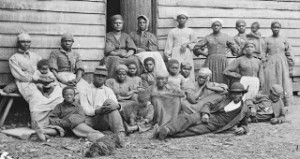Life for a slave was unsurprisingly hard. The children of slaves were born into slavery themselves, and were considered property of the master from the moment they were born, not children as part of a family. They were often sold several times throughout their life, often starting as early as age 3.
Some slave girls were able to play with other slave girls, or served as a companion for a daughter of the master, but most of life their was spent in work in the fields or the house. When they could, they played marbles, with hoops or rings, and London Bridge. Work was dictated by the master; some slaves were sent to the fields or for housework, but others were trained in specific skills – such as horse riders or basket makers. By learning these skills, some were able to hire themselves out in their free time and eventually buy their freedom. If they were a house slave, the physical labor might be less difficult, but women could also face sexual abuse from the white members of the house.
The main activities for slaves of any age were work and church socials. A very few slaves might have learned to read, but what little education a slave recieved normally came only from the Bible and church; most slaves were forbidden from learning to read, since reading gave them access to knowledge, and thus power. However, the character of a master had a great impact on slave life – some master were kind, and even educated the children, whereas others were harsh, and slaves were whipped or worse for even minor transgressions. Living conditions were dictated by the mistress, but slaves often lived in communal slave cabins or private shacks. Clothing was generally provided: slaves were often given one pair of shoes, one pair of socks/stockings, one hat, a jacket, two shirts, and two pairs of trousers a year, and expected to make due with these things. Sadly, many slaves only had the tiniest hope of achieving their own freedom.
-Tiffany Rhoades
Junior Girl
Girl Museum Inc.

